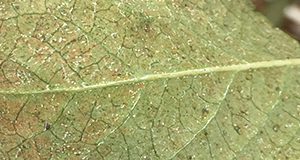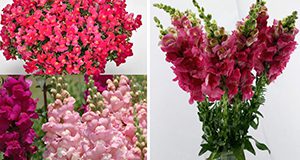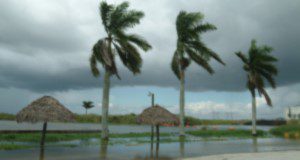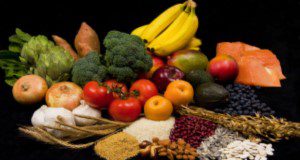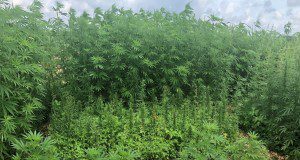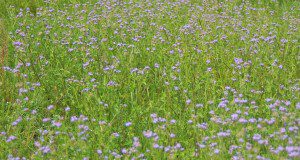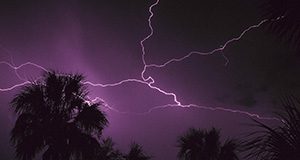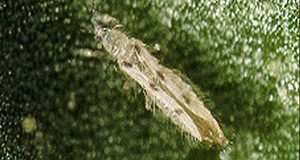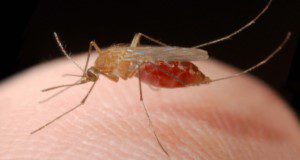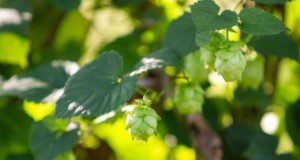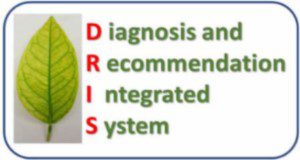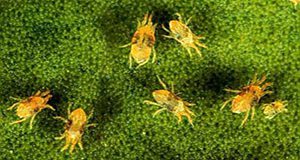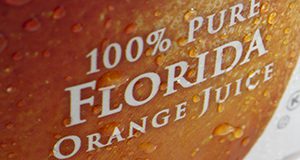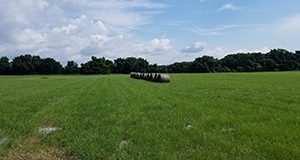This new 6-page document explains the proper way to prune fruit trees using hand tools. An important aspect of growing tropical and subtropical fruit trees is size control through pruning. In addition to size control, pruning also makes it easier to spray the tree and harvest fruit from the tree. Pruning also makes the tree more hardy to wind events and healthier in general because you can remove damaged or unhealthy parts of the tree. Written by Jeff Wasielewski, Jonathan Crane, and Carlos Balerdi, and published by the UF/IFAS Horticultural Sciences Department.
https://edis.ifas.ufl.edu/hs1372
Bacterial Black Spot (BBS) of Mango in Florida
Bacterial black spot, caused by the bacterium Xanthomonas citri pv. mangiferaeindicae, is a relatively new (~2015) bacterial disease in Florida that has the potential to limit mango production of some cultivars. This new 6-page fact sheet provides the current knowledge and status of the disease potential on various cultivars. Written by Jonathan Crane and Romina Gazis, and published by the UF/IFAS Horticultural Sciences Department.
https://edis.ifas.ufl.edu/hs1369
Mite Pests of Southern Highbush Blueberry in Florida
This 4-page document discusses life cycles, damage, monitoring, and management of southern red mites and false spider mites in southern highbush blueberries. Written by Oscar E. Liburd, Lorena Lopez, and Doug Phillips, and published by the UF/IFAS Entomology and Nematology Department, June 2020.
https://edis.ifas.ufl.edu/in1284
Development of a Model Mutagenesis System for Snapdragon
This 4-page document describes the advantages of snapdragon’s elegant transposon mutagenesis system and its connection to plant breeding. Written by Zhaoyuan Lian, Heqiang Huo, Sandra Wilson, and Jianjun Chen, and published by the UF/IFAS Environmental Horticulture Department, August 2020.
https://edis.ifas.ufl.edu/ep584
Climate Change and Florida: Frequently Asked Questions
Climate change is considered one of the biggest challenges facing society. As global temperatures continue to rise, we are threatened by melting ice sheets, rising sea levels, and extreme weather events. Climate change is also something that the people in south Florida live with daily. Still, the science of climate change is complicated, leaving many in the region looking for trusted information about why climate should matter to them. The purpose of this new 8-page FAQ document is to provide answers to commonly asked questions regarding climate change. The questions come from south Florida residents and municipal workers concerned with the climate outcomes to their region. The FAQ address several areas of concerns, including the basic science behind climate change, the projected impacts to residents of south Florida, and actions that individuals can take to reduce their carbon footprints. Written by Joshua Papacek, Ashley Smyth, Holly Abeels, and Alicia Betancourt, and published by the UF/IFAS Department of Soil and Water Sciences.
https://edis.ifas.ufl.edu/ss682
What the Agricultural Sector in Florida Needs to Know about Heat-Related Illness (HRI)
Heat-related illness (HRI) can range from rashes, fainting, and cramps to heat exhaustion and heat stroke. It can be fatal, and all outdoor workers in agriculture (as well as those in high-heat indoor settings such as greenhouses) are at risk. This new 6-page publication of the UF/IFAS Department of Agricultural Education and Communication provides basic information on how to recognize the symptoms of HRI, on the underlying physiological processes and related risk factors, and on how to treat it. This publication also provides a list of preventative measures that growers, supervisors, and agricultural workers can follow, along with links to additional resources. Written by Paul Monaghan, Karissa Raskin, Maria Morera, Antonio Tovar, Valerie Mac, and Joan Flocks.
https://edis.ifas.ufl.edu/wc359
Reducing Your Risk for Cancer: The Power of Food
Cancer is the #2 cause of death within the United States, where 2 out of every 5 people will be diagnosed with some form of cancer within their lifetime. Forty-five percent of cancer deaths may have been caused by risk that factors that you can change, such as weight, diet, and lifestyle. This new 6-page publication describes the modifiable risk factors for cancer and tips to reduce your risk for cancer. Written by Jodi Fitzgerald, Danielle Nelson, Madison Woodard, and Jeanette Andrade, and published by the UF/IFAS Food Science and Human Nutrition Department.
https://edis.ifas.ufl.edu/fs392
Hemp Fertilization: Current Knowledge, Gaps and Efforts in Florida: A 2020 Report
Hemp is an annual herbaceous plant that may be grown for fiber, seed, or flowers. Starting in April 2020, the Florida Department of Agriculture and Consumer Services began accepting applications for cultivation of hemp in Florida, with the potential for building a $20-$30 billion industry in the state. The statewide UF/IFAS Industrial Hemp Pilot Project is researching aspects of agronomic production for hemp cultivation. While a few other state soil testing laboratories provide soil tests and nutrient recommendations based on research and experience, at this time no Florida-specific data on nutrient requirements and fertilization are available. This new 5-page article, written by Rao Mylavarapu, Zachary Brym, Luis Monserrate, and Michael J. Mulvaney and published by the UF/IFAS Department of Soil and Water Sciences, provides a summary of published and personal communications from different states on hemp fertilization.
https://edis.ifas.ufl.edu/ss689
Biology and Management of Praxelis (Praxelis clematidea) in Ornamental Crop Production
Praxelis is a newly emerging weed species in Florida, one that Plant Protection and Quarantine (PPQ) is considering adding to the federal noxious weed list. The plant can be easily misidentified and confused with Ageratum houstonianum (bluemink) and Conoclinium coelestinum (blue mistflower) as well as several other species that have similar flower characteristics. This new 5-page article is written for green industry professionals and others to aid in the identification and management of praxelis in and around ornamental plants. Written by Yuvraj Khamare, Chris Marble, Shawn Steed, and Nathan Boyd, and published by the UF/IFAS Environmental Horticulture Department.
https://edis.ifas.ufl.edu/ep585
Strategies to Increase Personal Resilience in Disaster Response Efforts
This 3-page publication highlights strategies to help Extension professionals increase their personal resilience in disaster response efforts. Written by Amanda D. Ali, Angela Lindsey, Amy Harder, Lisa Lundy, and T. Grady Roberts, and published by the UF/IFAS Department of Agricultural Education and Communication, May 2020.
https://edis.ifas.ufl.edu/wc360
Trips: Ciclo de vida
Trips, morfología general, biología general, rango de hospederos de la plaga, enemigos naturales, y síntomas y daños.
This is the Spanish translation of ENY-879/IN1058, Pest Identification Guide: An Introduction to Thrips. It was written by Nicole Casuso and Hugh Smith, translated by Lorena Lopez, and published by the UF/IFAS Entomology and Nematology Department.
https://edis.ifas.ufl.edu/in1288
A Comparison of Planting Techniques for Submerged Aquatic Vegetation
Submerged aquatic vegetation has numerous benefits for aquatic ecosystems, from improving water quality to providing important habitat that supports a diverse food web. This new 6-page publication of the UF/IFAS Department of Soil and Water Sciences describes the breadth of options available to managers who wish to plant SAV at new locations. Because all methods have both benefits and drawbacks, and because all planting locations have different (often unknown) challenges for plant survival, managers may choose to try multiple methods to increase the likelihood for success. Written by Laura Reynolds, Carrie Reinhardt Adams, Enrique Latimer, Charles W. Martin, Christine Rohal, and Jodi Slater.
https://edis.ifas.ufl.edu/ss685
Don't Fake It, Make It! Thriving in Virtual Conferences and Meetings
Our ways of working, meeting, and networking have become more virtual than ever before. This series dives into the preparation needed to host a successful virtual experience, as well as steps participants can take to get the most benefit from a virtual conference or meeting. This series will also help hosts understand the value of online conferences and meetings and demonstrate how to create engagement in an online format. This new 4-page publication of the UF/IFAS Department of Agricultural Education and Communication, the first in the series, was written by Lauri M. Baker, Matt P. Benge, Anissa Zagonel, Jarred Shellhouse, Cheryl R. Boyer, and Phillip Stokes.
https://edis.ifas.ufl.edu/wc365
Conducting the Needs Assessment #10: The Delphi Technique
Previous publications in the Conducting the Needs Assessment series outlined why, how, and when Extension educators and other service providers should use needs assessments in their programs. The four preceding publications in the series provide Extension educators and other service providers with specific techniques that can be used in needs assessments, and this new 5-page publication provides an overview of using the Delphi technique to conduct a needs assessment. Written by Laura Warner and Amy Harder, and published by the UF/IFAS Department of Agricultural Education and Communication.
https://edis.ifas.ufl.edu/wc364
Using Social Media to Communicate in an Emergency Situation
The Prevent & Protect publication series focuses on the creation of different material formats to resonate with various audiences and ways to maximize their efficacy in communicating risk to the public about mosquito control. This new 4-page publication of the UF/IFAS Department of Agricultural Education and Communication explains how to engage in effective crisis communication and how to effectively use the Prevent & Protect emergency toolkit in a mosquito-related crisis situation. Written by Ashley Mcleod-Morin, Ricky Telg, Phillip Stokes, Alena Poulin, Shelli Rampold, Angela B. Lindsey, and Sandra Anderson.
https://edis.ifas.ufl.edu/wc363
LED light increases leaf area and root length of Humulus lupulus (var. Tettnanger) in vitro
Propagation of hops has traditionally been accomplished through vegetative techniques. A more modern technique, micropropagation, can be used to propagate hops and offers several advantages to vegetative techniques. Research examining the use of LED lights in plant production has observed its ability to promote growth in plants through emission of higher light quality, such as enhanced red and blue wavelength discharge. This new 5-page EDIS publication provides information on the use and application of LED lights to enhance leaf area and root length of hops. Written by Chi D. Nguyen, Dominic Vu, Heqiang Huo, and Brian Pearson, and published by the UF/IFAS Environmental Horticulture Department.
https://edis.ifas.ufl.edu/ep583
Computer Tools for Diagnosing Citrus Leaf Symptoms (Part 1): Diagnosis and Recommendation Integrated System (DRIS)
This new 2-page article provides instructions for using the Diagnosis and Recommendation Integrated System, or DRIS, a web tool designed for analyzing leaf nutrient concentrations of Florida citrus. Written by Arnold Schumann and published by the UF/IFAS Department of Soil and Water Sciences.
https://edis.ifas.ufl.edu/ss683
La araña roja – Ciclo de vida
La araña roja, Tetranychus urticae Koch, morfología general, biología general, espectro de hospederos de la plaga, enemigos naturales, y síntomas y daños.
This is the Spanish translation of ENY-880/IN1059, Pest Identification Guide: Two-spotted Spider Mite, Tetranychus urticae Koch. It was written by Nicole Casuso and Hugh Smith, translated by Lorena Lopez, and published by the UF/IFAS Entomology and Nematology Department.
https://edis.ifas.ufl.edu/in1287
Orange Juice Consumers Response to the Covid-19 Outbreak
This 4-page fact sheet written by Yan Heng, Marisa Zansler, and Lisa House and published by the UF/IFAS Food and Resource Economics Department presents consumers’ responses to a monthly survey and provides a look at those consumers who have contributed to a surge in orange juice sales since April. It is intended to help the industry understand the possible impacts of the COVID-19 pandemic and develop marketing plans to sustain orange juice purchases beyond the short run.
https://edis.ifas.ufl.edu/fe1082
Bermudagrass Production in Florida
This 10-page document is primarily for Extension agents and farmers looking for detailed information about bermudagrass production in Florida, including cultivar characteristics, fertilization, and pest and disease management. Written by M. O. Wallau, J. M. B. Vendramini, and J. K. Yarborough, and published by the UF/IFAS Agronomy Department, revised May 2020.
https://edis.ifas.ufl.edu/aa200


